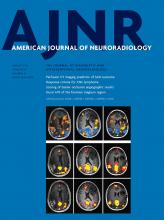Research ArticleFunctional
Functional MRI Shows Altered Deactivation and a Corresponding Decrease in Functional Connectivity of the Default Mode Network in Patients with Gliomas
Y.M. Maniar, K.K. Peck, M. Jenabi, M. Gene and A.I. Holodny
American Journal of Neuroradiology August 2021, 42 (8) 1505-1512; DOI: https://doi.org/10.3174/ajnr.A7138
Y.M. Maniar
aFrom the Department of Radiology (Y.M.M., K.K.P., M.J., M.G., A.I.H.), Memorial Sloan Kettering Cancer Center, New York, New York
K.K. Peck
aFrom the Department of Radiology (Y.M.M., K.K.P., M.J., M.G., A.I.H.), Memorial Sloan Kettering Cancer Center, New York, New York
bDepartment of Medical Physics (K.K.P.), Memorial Sloan Kettering Cancer Center, New York, New York
M. Jenabi
aFrom the Department of Radiology (Y.M.M., K.K.P., M.J., M.G., A.I.H.), Memorial Sloan Kettering Cancer Center, New York, New York
M. Gene
aFrom the Department of Radiology (Y.M.M., K.K.P., M.J., M.G., A.I.H.), Memorial Sloan Kettering Cancer Center, New York, New York
A.I. Holodny
aFrom the Department of Radiology (Y.M.M., K.K.P., M.J., M.G., A.I.H.), Memorial Sloan Kettering Cancer Center, New York, New York
cDepartment of Radiology (A.I.H.), Weill Medical College of Cornell University, New York, New York
dDepartment of Neuroscience (A.I.H.), Weill-Cornell Graduate School of the Medical Sciences, New York, New York

References
- 1.↵
- Greicius MD,
- Krasnow B,
- Reiss AL, et al
- 2.↵
- Fox MD,
- Snyder AZ,
- Vincent JL, et al
- 3.↵
- Buckner RL,
- Andrews-Hanna JR,
- Schacter DL
- 4.↵
- Raichle ME,
- MacLeod AM,
- Snyder AZ, et al
- 5.↵
- Shulman GL,
- Fiez JA,
- Corbetta M, et al
- 6.↵
- Andrews-Hanna JR,
- Reidler JS,
- Sepulcre J, et al
- 7.↵
- Mason MF,
- Norton MI,
- Van Horn JD, et al
- 8.↵
- Gusnard DA,
- Akbudak E,
- Shulman GL, et al
- 9.↵
- Daselaar SM,
- Prince SE,
- Cabeza R
- 10.↵
- Anticevic A,
- Cole MW,
- Murray JD, et al
- 11.↵
- 12.↵
- 13.↵
- Jeong B,
- Kubicki M
- 14.↵
- Pihlajamaki M,
- Sperling RA
- 15.↵
- 16.↵
- Rogers BP,
- Morgan VL,
- Newton AT, et al
- 17.↵
- 18.↵
- 19.↵
- 20.↵
- 21.↵
- Kennedy DP,
- Courchesne E
- 22.↵
- Bluhm RL,
- Miller J,
- Lanius RA, et al
- 23.↵
- 24.↵
- 25.↵
- Cox RW
- 26.↵
- Woolrich MW,
- Jbabdi S,
- Patenaude B, et al
- 27.↵
- Holodny AI,
- Schulder M,
- Liu WC, et al
- 28.↵
- Holodny AI,
- Schulder M,
- Liu WC, et al
- 29.↵
- 30.↵
- 31.↵
- 32.↵
- 33.↵
- 34.↵
- Agarwal S,
- Sair HI,
- Gujar S, et al
- 35.↵
- Agarwal S,
- Lu H,
- Pillai JJ
- 36.↵
- 37.↵
- Agarwal S,
- Sair HI,
- Pillai JJ
- 38.↵
In this issue
American Journal of Neuroradiology
Vol. 42, Issue 8
1 Aug 2021
Advertisement
Y.M. Maniar, K.K. Peck, M. Jenabi, M. Gene, A.I. Holodny
Functional MRI Shows Altered Deactivation and a Corresponding Decrease in Functional Connectivity of the Default Mode Network in Patients with Gliomas
American Journal of Neuroradiology Aug 2021, 42 (8) 1505-1512; DOI: 10.3174/ajnr.A7138
0 Responses
Jump to section
Related Articles
- No related articles found.
Cited By...
- No citing articles found.
This article has not yet been cited by articles in journals that are participating in Crossref Cited-by Linking.
More in this TOC Section
Similar Articles
Advertisement











